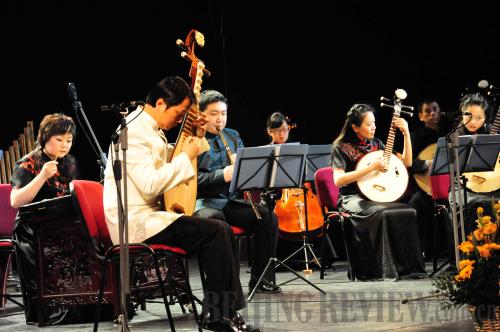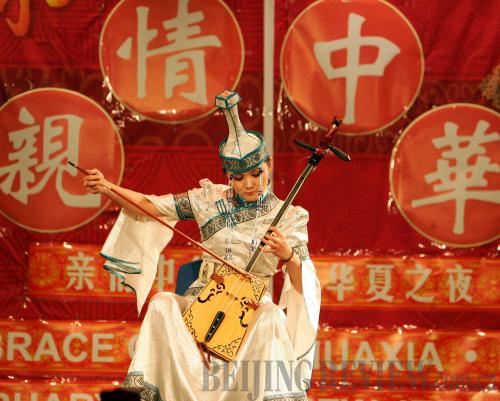|
 |
|
HAPPY SPRING: Artists play at a folk music concert celebrating the Chinese Spring Festival in Vilnius, capital of Lithuania, on February 15 (XINHUA) |
On January 27, a concert celebrating the upcoming Chinese Lunar New Year, which fell on February 3 this year, was performed by musicians from China's Shanghai Traditional Music Orchestra in Paris.
The performance was warmly welcomed by the locals. Many audiences were fascinated by the charming melodies from China and appraised the virtuosity of Chinese musicians highly. Shortly afterward, in order to inform the curiosity of French audiences about Chinese folk music and about Chinese culture, Radio France for the first time invited the musicians to its recording studio to show the uniqueness of this kind of music to the French people.
Soon later, on February 9, a Chinese folk music concert was held in Opole, Poland to celebrate this most significant traditional Chinese festival. This also caused a sensation among local audiences.
Unique style
 |
|
HORSE FIDDLE: A Chinese artist plays a morin khuur, a horse-head-like string instrument, during a concert in New Jersey, the United States, on February 5 (XINHUA) |
In recent years, Chinese folk music orchestras have ventured abroad and performed time and again, bringing their colorful but unique Chinese flavor to the world and, in the meantime, arousing local peoples' interest in this traditional art form. Currently, for many youths in countries such as Japan, South Korea, Malaysia and Thailand the learning of traditional Chinese folk musical instruments has become fashionable. In Singapore, the music was introduced to classes at primary schools and secondary schools as well as universities.
"As China has developed swiftly in the past few decades, its folk music has created interest internationally. Many foreign composers have begun to try mixing Chinese elements into their own works," said Li Binyang, a commissioned composer of the Chinese National Orchestra (CNO). "A month ago, an American university professor became very excited after listening to one of my student's pieces of music. He said he was composing Chinese folk music type work but could not find any sense of direction. Then, the music score helped."
In China, folk music has also been flourishing in recent years and has made great progress in the last decade. A greater number of Chinese youths are studying traditional folk instruments. About 1 million are studying the guzheng, more than 600,000 the erhu, 500,000 the dulcimer and 400,000 studying the bamboo flute, said Zhang Dianying, Secretary General of China Nationalities Orchestra Society.
Cultural education
Playing folk music can entertain both the players and others. It is a kind of spiritual pursuit after satiation with a material life, Zhang said.
Renowned guzheng player Yuan Sha said folk music's rise had partly due to the popularity of the study of ancient Chinese civilization. "Many people study tea arts and traditional painting at the start, and gradually they begin to learn folk music," Yuan said. Yuan thought the success of popular group the Twelve Girls Band was also an important factor attracting children and parents' attention to folk music. The band consists of 12 girls performing Chinese folk musical instruments. They combine folk music with pop, creating a totally new pattern of performing, arousing strong interest among their audiences.
Learning folk music is also a good way to cultivate one's character. "Learning the guzheng not only makes the students become quiet and elegant but also benefits them a lot in the future," said one folk music teacher surnamed Shen. She said most began to learn their instruments when they are in kindergarten.
A resident in Qingdao, Shandong Province resident said his son had been studying the guzheng since he was 5. "My son loves the guzheng very much. Now many kids learn the piano, but we think playing the piano is not a specialty anymore," he said, "To some extent, learning folk music can inspire children's interests in traditional Chinese culture and is conducive to the inheritance of our culture." Learning folk music was not merely learning to play musical instruments, but students would also go on to study Chinese opera and literature, which was beneficial to the children's cultivation.
|
